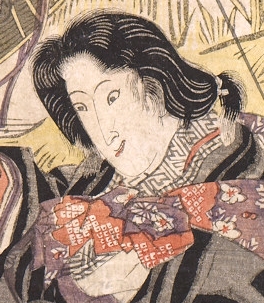Kabuki Plus
Homosexuality
notable!These days some countries recognize same-sex marriages, and Japan allows civil partnerships in some localities. In the Edo Period, however, the only way for a monk and young boy to be together was to commit joint suicide and hope to be reincarnated as male and female in the next life. Chigogafuchi (chigo means young boy), a rocky marine plateau in Enoshima, strongly resembles the stage set of the current play.
Seigen-Sakura genre
A genre of puppet and Kabuki plays deriving from the play Isshin Niga Byakudo (“One Heart, Two Rivers, White Road”). The main storyline involves a senior monk Seigen of Kyoto’s Kiyomizu Temple who falls for Princess Sakura, which eventually leads to his death. Tsuruya Nanboku combines this story with the world of another tragic tale, Sumida River (see below), to give it depth and complexity.
Sumida River stories
notable!The Noh play Sumida River tells of Umewakamaru, the child of a Kyoto nobleman. He is kidnapped by a slave trader and taken to Edo, where he dies along the banks of the Sumida River. The mother pursues him and, learning of his death, goes mad. This story is combined with a section from the medieval Tales of Ise in which Narihira, expelled from Kyoto, goes toward Edo and sees a bird known as miyakodori (capital bird). He recites a famous poem, “If your name is true, can you tell me where the capital Kyoto is?” This combined tale forms its own genre in puppet and Kabuki dramas. Examples include Twin Sumida River, which tell of twin boys Umewaka and Matsuwaka; Never-Ending Memories of Sumida River, where a disgraced monk is kicked out of the temple for mistreating Matsuwaka; the present play, which tells of Princess Sakura; Sumida River and Flower-Covered Palace, which features the relationship between Matsuwaka and the sisters Hanako and Sakura; and The Capital Bird, the Brothel and the White Waves, which opens with the murder of Umewaka by Shinobu no Soda. A memorial service for Umewaka is still held on April 15 in Mokubo Temple in Tokyo’s Sumida Ward. The day tends to be rainy, which is said to be Umewaka’s tears.
Thousand-ryo eyes

Iwai Hanshiro V, who originated the role of Princess Sakura, was a major female-role specialist in the early 19th century known for his “thousand-ryo eyes” (a ryo was a unit of currency). He was beautiful and cheerful in female roles, known especially for his delivery of lines. His skilful presentation of the princess’ noble speech and low dialect of a prostitute made this a memorable character. He was also known for his performances of wicked old women. 【picture】Iwai Hanshiro V Sumida River and Flower-Covered Palace Seigenni (C)Waseda University Theatre Museum
Wind-chime princess
Princess Sakura, sold off to a brothel by her husband, comes to be called the wind-chime princess for her slim arms, a bell tattoo that is mistaken for a wind chime, and her noble speech.
Utagawa Toyokuni I (1769-1825)
The founder of the Utagawa School of ukiyoe prints. He created many portraits of beautiful women and picture books, but from around 1804, concentrated largely on actor portraits. His pictures are said to adeptly capture the atmosphere of Nanboku’s plays. One particularly well known work depicts a scene where Sakura, with untidy hair, old grass coat and an umbrella, crosses paths with Seigen carrying a baby.
T&T Cheerleaders
notable!There was a unique occurrence at a performance of the show in Shinbashi Enbujo Theater in June 1975. A woman’s group called the T&T Cheerleaders, named after the lead actors Takao (today, Nizaemon) as Gonsuke and Tamasaburo as Sakura/Shiragiku, consisted mainly of university students and young office workers. They were not part of the actors’ official fan club, but came together specifically to urge more Tsuruya Nanboku plays with the two stars. The group, which no longer exists, signed a petition that they presented to the producers. It was a movement inspired by the refreshing artistry that Takao and Tamasaburo brought to the heavy content of Tsuruya’s plays.
Naimaze mixture of plays
Naimaze, literally the intertwining of thread into rope, refers to a mixture of two or more completely different stories into a new work. Sakurahime combines the well known Seigen-Sakura and Sumida River stories into one. Princess Sakura’s dialogue is also a naimaze mix of noble speech with the dialect of a low-life prostitute.